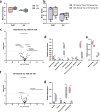Minibioreactor arrays to model microbiome response to alcohol and tryptophan in the context of alcohol-associated liver disease
- PMID: 39567509
- PMCID: PMC11579296
- DOI: 10.1038/s41522-024-00602-9
Minibioreactor arrays to model microbiome response to alcohol and tryptophan in the context of alcohol-associated liver disease
Abstract
The intestinal microbiota (IM) plays a role in the severity of alcohol-associated liver disease. Modifying severe alcohol-associated hepatitis (AH) dysbiosis improves liver injury through tryptophan (Trp) metabolites and the aryl hydrocarbon receptor (AhR). However, Trp's effect on the IM in alcohol use disorder (AUD) patients remains unclear. Here, we used an in vitro microbiota modeling system named Minibioreactor arrays (MBRAs). Feces from AUD patients with or without AH were treated with low, normal, or high Trp concentrations, with subsequent treatment with alcohol. Microbiota composition and AhR activity were studied. We showed that microbial communities from donors were maintained in MBRAs. High and low Trp increased the abundance of pathogen Escherichia Shigella. In the absence of alcohol, Trp changed more bacteria in AUD IM compared to AH IM. Normal Trp increased the AhR activity. Overall, maintaining normal Trp levels may prevent dysbiosis in AUD or AH, pending in vivo confirmation.
© 2024. The Author(s).
Conflict of interest statement
Competing interests: D.C. received travel funds from Biocodex and Gilead, lecture fees from Gilead, and royalties from John Libbey Eurotext. G.P. received travel funds from Janssen and Gilead, consulting fees from Bayer, Biocodex, Roche, Gilead, Pierre Fabre, and Servier, and royalties from Elsevier-Masson, Solar, Flammarion/Versilio, and John Libbey Eurotext. A.M.C. received royalties from Elsevier-Masson, Solar, Flammarion/Versilio, and John Libbey Eurotext. All other authors declare no conflicts of interest.
Figures






References
MeSH terms
Substances
LinkOut - more resources
Full Text Sources
Medical

